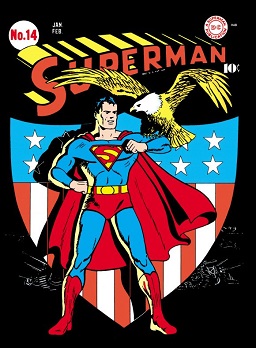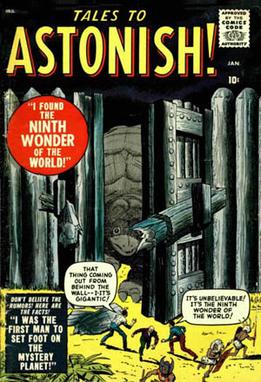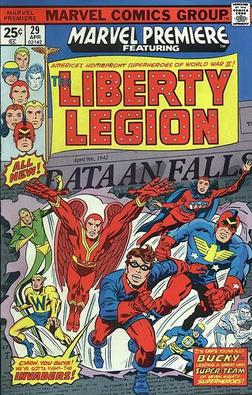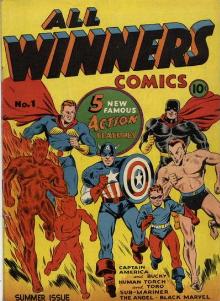
The Golden Age of Comic Books describes an era of American comic books from 1938 to 1956. During this time, modern comic books were first published and rapidly increased in popularity. The superhero archetype was created and many well-known characters were introduced, including Superman, Batman, Robin, Captain Marvel, Captain America, and Wonder Woman.

Timely Comics is the common name for the group of corporations that was the earliest comic book arm of American publisher Martin Goodman, and the entity that would evolve by the 1960s to become Marvel Comics.

Tales to Astonish is the name of two American comic book series, and a one-shot comic, all published by Marvel Comics.

Marvel Mystery Comics is an American comic book series published during the 1930s–1940s period known to fans and historians as the Golden Age of Comic Books. It was the first publication of Marvel Comics' predecessor, Timely Comics, a division of Timely Publications.

The Invaders is the name of two fictional superhero teams appearing in American comic books published by Marvel Comics.

Miss America is a superhero appearing in American comic books published by Marvel Comics. Created by writer Otto Binder and artist Al Gabriele, the character first appeared in Marvel Mystery Comics #49 in the Golden Age of Comic Books. Madeline Joyce is the first incarnation of Miss America. The character has also been a member of the Invaders and Liberty Legion at various points in her history.

All Select Comics is a 1943–1945 American comic book series published by Timely Comics, the 1940s predecessor of Marvel Comics, during the period fans and historians call the Golden Age of comic books. An omnibus series with several different superhero and other features each issue, it primarily starred Captain America and the original Human Torch, two of Timely's most popular characters, as well as fellow Timely star the Sub-Mariner in several.

The All-Winners Squad is a fictional superhero team appearing in American comic books published by Marvel Comics. The company's first such team, it first appeared in All Winners Comics #19, published by Marvel predecessor Timely Comics during the period fans and historians call the Golden Age of Comic Books.

Jeffrey Solomon Mace, also known as the Patriot and Captain America, is a superhero appearing in American comic books published by Marvel Comics. The character was created during the 1940s, a period fans and historians call the Golden Age of Comic Books. As the Patriot, he first appeared in Human Torch Comics #4, published by Marvel's 1940s precursor, Timely Comics.

Atlas Comics was the 1950s comic-book publishing label that evolved into Marvel Comics. Magazine and paperback novel publisher Martin Goodman, whose business strategy involved having a multitude of corporate entities, used Atlas as the umbrella name for his comic-book division during this time. Atlas evolved out of Goodman's 1940s comic-book division, Timely Comics, and was located on the 14th floor of the Empire State Building. This company is distinct from the 1970s comic-book company, also founded by Goodman, that is known as Atlas/Seaboard Comics.

Marvel Super-Heroes is the name of several comic book series and specials published by Marvel Comics.

The Liberty Legion is a fictional superhero team appearing in American comic books published by Marvel Comics. The team was first created in 1976 and set during World War II. Composed of existing heroes from Marvel's 1940s Golden Age of Comic Books predecessor, Timely Comics, the team was assembled and named by writer Roy Thomas in a story arc running through The Invaders #5–6 and Marvel Premiere #29–30. Inspired by the Liberty Legion, a second fictional team called the Liberteens was published in 2007 as part of the Avengers Initiative.

Blue Diamond is a fictional superhero appearing in American comic books published by Marvel Comics, debuting under the company's 1940s forerunner, Timely Comics. The character was created in 1941 by Ben Thompson, who also drew the first comic book adventures of Ka-Zar the Great and Citizen V for Timely, as well as the Masked Marvel for Centaur Publications and Dr. Frost for Prize Comics.

Jack Frost is a fictional superhero appearing in American comic books published by Marvel Comics. The character first appeared in 1941 in U.S.A. Comics published by Marvel's 1940s forerunner Timely Comics, during the period fans and historians call the Golden Age of comic books.

Daring Mystery Comics is an American comic-book series published by Timely Comics, a predecessor of Marvel Comics, during the 1930-1940s period fans and historians call the Golden Age of Comic Books. Primarily a superhero anthology, it ran eight issues from 1940 to 1942, and is notable for work by Carl Burgos, Bill Everett, Alex Schomburg, and the team of Joe Simon & Jack Kirby.
Al Gabriele was an American comic book artist during the 1940s period fans and historians call the Golden Age of comic books. He was known for his work on some of Marvel Comics' earliest Captain America and Sub-Mariner stories, and for co-creating the company's superheroes Black Marvel, Miss America, and possibly, the Whizzer.

U.S.A. Comics was an American comic-book series published by Marvel Comics' 1930–1940s predecessor, Timely Comics, during the period fans and historians call the Golden Age of comic books.

The Whizzer is a superhero appearing in American comic books published by Marvel Comics. He first appeared during the period called the Golden Age of Comic Books.
Mystic Comics is the name of three comic book series published by the company that eventually became Marvel Comics. The first two series were superhero anthologies published by Marvel's 1930-1940s predecessor, Timely Comics, during what fans and historians call the Golden Age of comic books. The third, simply titled Mystic, was a horror fiction-suspense anthology from Marvel's 1950s forerunner, Atlas Comics.

The Destroyer is the name of three fictional superheroes appearing in American comic books published by Marvel Comics. The original incarnation was created by writer Stan Lee and artist Jack Binder, and first appeared in Mystic Comics #6, being one of Lee's earliest creations during the Golden Age of comic books.

















